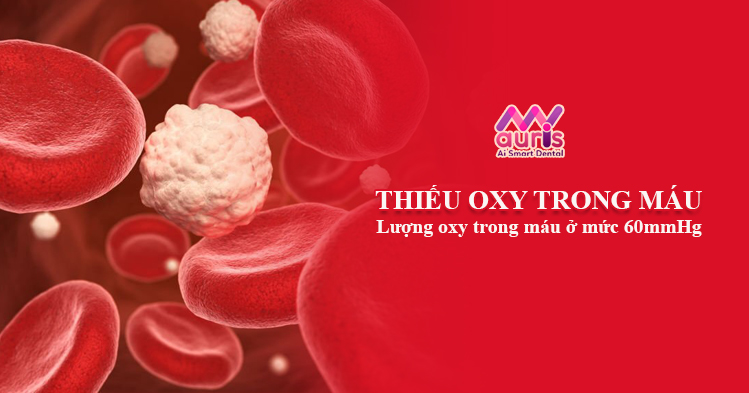Hypoxia is when our body does not provide enough oxygen for cells to function. This is a complex disease in humans. Join My Auris to find out the causes, signs and effective clinics for hypoxia in the blood!
What is hypoxia in the blood?
Hypoxia is a condition in which oxygen in the blood is lower than normal, especially in the arteries. Besides, lack of blood oxygen is also a sign that the body has problems with the respiratory tract, blood circulation and causes symptoms such as difficulty breathing.
Normally, the average amount of oxygen in the blood ranges from 75 to 100mmHg. If you are below 60mmHg then you experience hypoxia in the blood. As for oxygen saturation in the blood, if it is at a normal level it will probably be between 95% and 100%, while below 90% is low.
So, to know how much oxygen is in your blood (SpO2)? – You need to use an oxygen meter to know the percentage of oxygen in your blood.
- SpO2 over 97%; Good blood oxygen
- SpO2 from 95% – 96%: Average blood oxygen.
- SpO2 below 94%: Low blood oxygen.
- SpO2 below 92%: Signs of very severe respiratory failure and clinical emergency. At this time, the support of an oxygen ventilator is needed.

Signs of lack of oxygen in the blood
Although the symptoms in each case may be different, the most common symptoms in Arterial hypoxemia and tissue hypoxia include:
- Changes skin color, from pale to purple-red
- Eyes alert, confused.
- Ho
- Difficulty breathing, shortness of breath
- Sweating
- Wheezing
If symptoms of arterial hypoxemia and tissue hypoxia appear, seek medical assistance immediately.

Causes of lack of oxygen in the blood
There are many cases that lead to a lack of oxygen in the blood, making the body unhealthy, specifically:
Respiratory hypoxia
Respiratory hypoxia is common when you are in places with thin air like flying, climbing mountains or living in high mountains. Some symptoms are as follows:
- You feel erratic fatigue, headaches, impaired memory, slow reflexes, nausea, heart arrhythmia, etc. due to lack of oxygen in the body, increased CO2 levels at high altitude leading to alkalosis. If you do not handle it promptly, the nervous system can have convulsions leading to coma and death.
- Visual and hearing disorders are also a manifestation of lack of respiratory oxygen.
- Altitude 6000m is the final limit that humans can endure low oxygen levels, if going higher At this level, you may suffer from lack of oxygen, possibly even death.
Lack of oxygen due to disease
Some diseases related to the heart, The lungs and blood reduce the ability to transport oxygen, leading to lack of oxygen. Such as: blood pressure, heart failure, mental shock, anemia, etc., causing a decrease in the number of red blood cells and hemoglobin, affecting oxygen transport. cell
Causes of cellular respiration can be:
- Substrate deficiency (lack of food intake, diabetes, failure weakness,..) causes lack of vitamins and enzymes of cellular respiration.
- Intoxication with substances that inhibit cellular respiration such as sleeping pills, CO, H2S, As, toxins created during infections, toxic tumors,…
In reality, different types of hypoxia often combine with each other. Clinical examination and full monitoring of biological signs are required to detect it. Providing oxygen is a good measure, but it cannot be used in all cases, but must depend on the nature and extent, depending on the cause, to have appropriate treatment.

What to do when there is a lack of oxygeny in the blood
To know your body condition, use a SpO2 machine to measure the oxygen concentration in the blood. If the SpO2 concentration drops too much according to the prescribed excess index. Therefore, you should do the following:
- Add more antioxidants to your diet: Helps improve storm levels. You can also consider eating foods rich in Omega -3 and omega – 6 fatty acids because these substances increase the ability of hemoglobin to carry oxygen in the blood.
- Practice slow and deep breathing: Practicing slow, deep breathing helps bring more air into the lungs and thus the body receives more oxygen. You can use the nose breathing method.
- Drink plenty of water: Filtered water is essential for blood oxygenation. Helps the body provide enough water and is also another important method to improve blood oxygen saturation levels. When you drink lots of water, your body improves its ability to supply oxygen and release carbon dioxide. As a result, the body’s oxygen saturation level improves. Add 2 -3 liters of water per day.
- Exercise: You can do light exercises such as aerobics, walking, cycling (in place) to increase your body’s endurance and immunity. Besides, it helps the body’s cells absorb and use available oxygen better, thereby improving the body’s SpO2 levels.
Supplement foods to increase the body’s resistance
- Green vegetables: Green leafy vegetables such as broccoli, spinach, and kale are rich in nutrients for the body such as Vitamin K, Lutein, Folate and Beta carotene. These foods help slow down cognitive decline due to aging.
- Omega-rich fish – 3: Fatty fish provide a rich source of Omega fatty acids. Besides, you should try to eat at least two to three fish meals a week to ensure adequate supply of the necessary amount of Omega 3. Choose fish that contain less heavy metals such as salmon, cod, and canned tuna.
- Vegetables and fruits: Vegetables such as celery, pumpkin, carrots,… are foods that contain many good vitamins and minerals such as iron, but also help increase metabolism and increase blood circulation.
Hope this article helps you find the cause of lack of oxygen in the blood. From there, it will help you have timely treatment and avoid unfortunate situations.
Kim Dung





